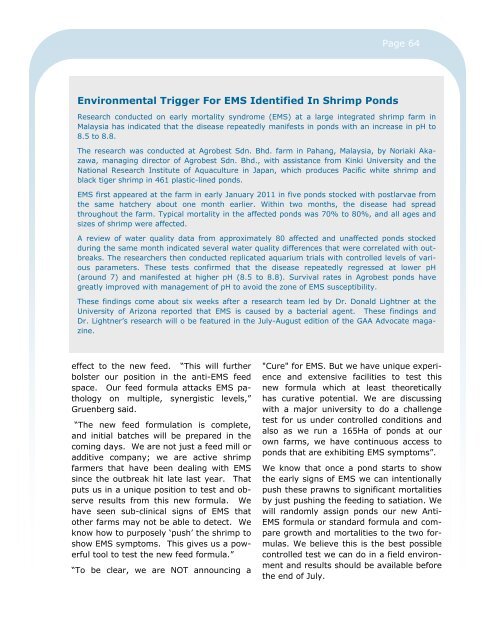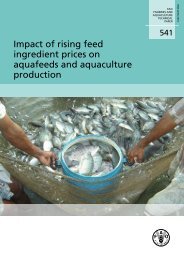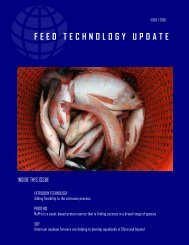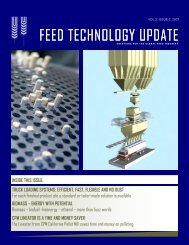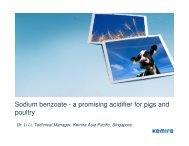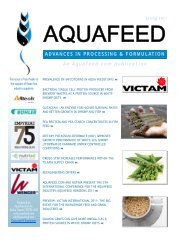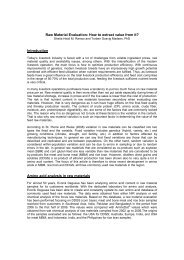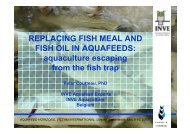Download - AquaFeed.com
Download - AquaFeed.com
Download - AquaFeed.com
- No tags were found...
You also want an ePaper? Increase the reach of your titles
YUMPU automatically turns print PDFs into web optimized ePapers that Google loves.
Page 64Environmental Trigger For EMS Identified In Shrimp PondsResearch conducted on early mortality syndrome (EMS) at a large integrated shrimp farm inMalaysia has indicated that the disease repeatedly manifests in ponds with an increase in pH to8.5 to 8.8.The research was conducted at Agrobest Sdn. Bhd. farm in Pahang, Malaysia, by Noriaki Akazawa,managing director of Agrobest Sdn. Bhd., with assistance from Kinki University and theNational Research Institute of Aquaculture in Japan, which produces Pacific white shrimp andblack tiger shrimp in 461 plastic-lined ponds.EMS first appeared at the farm in early January 2011 in five ponds stocked with postlarvae fromthe same hatchery about one month earlier. Within two months, the disease had spreadthroughout the farm. Typical mortality in the affected ponds was 70% to 80%, and all ages andsizes of shrimp were affected.A review of water quality data from approximately 80 affected and unaffected ponds stockedduring the same month indicated several water quality differences that were correlated with outbreaks.The researchers then conducted replicated aquarium trials with controlled levels of variousparameters. These tests confirmed that the disease repeatedly regressed at lower pH(around 7) and manifested at higher pH (8.5 to 8.8). Survival rates in Agrobest ponds havegreatly improved with management of pH to avoid the zone of EMS susceptibility.These findings <strong>com</strong>e about six weeks after a research team led by Dr. Donald Lightner at theUniversity of Arizona reported that EMS is caused by a bacterial agent. These findings andDr. Lightner’s research will o be featured in the July-August edition of the GAA Advocate magazine.effect to the new feed. “This will furtherbolster our position in the anti-EMS feedspace. Our feed formula attacks EMS pathologyon multiple, synergistic levels,”Gruenberg said.“The new feed formulation is <strong>com</strong>plete,and initial batches will be prepared in the<strong>com</strong>ing days. We are not just a feed mill oradditive <strong>com</strong>pany; we are active shrimpfarmers that have been dealing with EMSsince the outbreak hit late last year. Thatputs us in a unique position to test and observeresults from this new formula. Wehave seen sub-clinical signs of EMS thatother farms may not be able to detect. Weknow how to purposely ‘push’ the shrimp toshow EMS symptoms. This gives us a powerfultool to test the new feed formula.”“To be clear, we are NOT announcing a"Cure" for EMS. But we have unique experienceand extensive facilities to test thisnew formula which at least theoreticallyhas curative potential. We are discussingwith a major university to do a challengetest for us under controlled conditions andalso as we run a 165Ha of ponds at ourown farms, we have continuous access toponds that are exhibiting EMS symptoms”.We know that once a pond starts to showthe early signs of EMS we can intentionallypush these prawns to significant mortalitiesby just pushing the feeding to satiation. Wewill randomly assign ponds our new Anti-EMS formula or standard formula and <strong>com</strong>paregrowth and mortalities to the two formulas.We believe this is the best possiblecontrolled test we can do in a field environmentand results should be available beforethe end of July.


